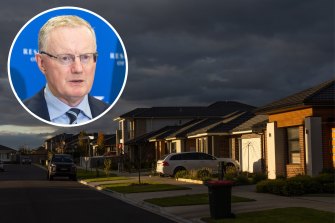The Reserve Bank has lifted interest rates for a historic fourth month in a row, taking the cash rate to 1.85 per cent as it works to dampen rising inflation.
RBA governor Philip Lowe said the board decided to increase the cash rate by 0.5 percentage points following Tuesday’s meeting. The bank has now raised the cash rate by 1.75 percentage points in four months, adding $770 a month to repayments on an $800,000 mortgage.
Governor Philip Lowe (inset). There are indications the RBA’s rate tightening is starting to have an impact beyond the housing market.Credit:Jason South, Louie Douvis
Data from the Australian Bureau of Statistics last week show inflation rose to 6.1 per cent through the past 12 months, driven by higher building and fuel prices.
The result was slightly lower than market and economists’ expectations but was still the highest level of inflation recorded in 20 years.
There are indications the RBA’s rate tightening is starting to have an impact beyond the housing market, with ANZ data showing job ads fell 1.1 per cent last month.
Economists from investment group Jarden expect home prices to fall by 15 to 20 per cent by the end of 2023, and predict steeper falls in Sydney and Melbourne because of affordability constraints.
Recent data from CoreLogic showed national home values have fallen 2 per cent from their April peak, after rising 28.6 per cent during the first two years of the coronavirus pandemic.
At the same time, consumer confidence has continued to rise, going up for the third week in a row despite higher inflation.
But ANZ head of Australian economics David Plank said sentiment remained very low and was vulnerable to more hikes from the RBA.
“The sharp fall in petrol prices over the past three weeks may have been more important for sentiment,” he said.
Speaking before the RBA announcement, Treasurer Jim Chalmers said higher interest rates would make life harder for many Australians and the government had to make the RBA’s job “as easy as possible” when it came to taking heat out of the economy and bringing inflation down.
“That means not splashing cash around unnecessarily,” Chalmers said. “It means dealing with the supply-side issues in the economy where we can so that we make the job of the Reserve Bank easier, not harder.”
ABS data suggest rate rises are having an impact on activity in the property market.
Loans for owner-occupiers fell by 3.3 per cent in June to be 9.6 per cent lower than a year ago. Loans to investors dropped by 6.3 per cent in June but are still up 17.3 per cent on the same time in 2021.
First-time buyers are being stung by a combination of high prices, the end of various government subsidies and higher rates. Loans taken out by first-timers fell by 10 per cent in June to be 29 per cent lower over the past 12 months.
More to come
Cut through the noise of federal politics with news, views and expert analysis from Jacqueline Maley. Subscribers can sign up to our weekly Inside Politics newsletter here.
Most Viewed in Politics
From our partners
Source: Read Full Article
